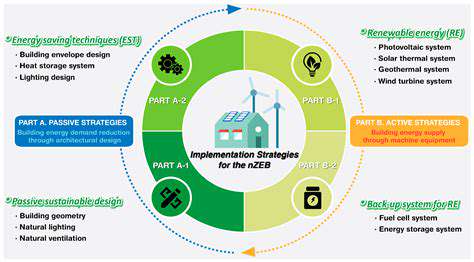How to Plan a Customized Soft Decoration Strategy
Understanding Your Space's Dimensions and Layout
One of the most important steps in designing a personalized space involves carefully assessing its physical dimensions and layout. Taking precise measurements of every room—including length, width, height, and any unique architectural features like alcoves—is fundamental. Creating detailed floor plans or even 3D models can provide a clearer picture of how furniture arrangements will work and how natural light will move through the space. This foundational work ensures the final design harmonizes with the existing structure while minimizing wasted space or awkward placements.
Pay close attention to how people move through the area. Are there bottlenecks or underutilized zones that could be optimized? Take note of fixed elements like doorways, windows, and fireplaces, as these will influence your design choices. This thorough analysis sets the stage for smart decisions about furniture, room functionality, and visual appeal.
Identifying Natural Light and Potential Shadow Areas
Sunlight plays a transformative role in shaping a room's ambiance and practicality. Observe how daylight enters the space at different times, noting window orientation, size, and any obstructions like trees or neighboring buildings. This awareness helps you position furniture and activities to maximize well-lit areas while compensating for darker corners. Seasonal changes in sunlight should also inform your design strategy, as winter light differs significantly from summer light.
Pinpointing shadow-prone zones—especially during peak usage hours—allows for strategic artificial lighting plans. Addressing these lighting needs upfront creates a more inviting and functional environment, particularly in rooms with limited natural illumination.
Assessing Existing Features and Personal Preferences
Architectural elements like fireplaces, built-ins, or distinctive flooring often serve as natural anchors for your design. Rather than working against these features, find ways to highlight them in your layout. For instance, a beautiful fireplace might become a living room's centerpiece, while custom shelving could showcase treasured items. Thoughtful integration of these existing elements typically yields a more authentic and unified design.
Your daily habits and aesthetic tastes should heavily influence the space's direction. What activities will occur here? What mood do you want to cultivate? Answering these questions helps create an environment that truly supports your lifestyle. This might mean selecting particular color palettes, materials, or furniture styles that resonate with you personally while ensuring the space remains practical for everyday use.
Selecting the Right Soft Furnishings: Textiles and Accessories
Choosing the Right Fabrics
Fabric selection significantly impacts both the look and functionality of soft furnishings. Consider the room's purpose and your desired aesthetic—a sumptuous velvet might suit a formal sitting area, while sturdy performance fabric would better serve a busy family room. Be honest about maintenance preferences; delicate materials like silk demand careful handling, while cotton and synthetic blends offer easier upkeep.
Different textiles bring distinct textures, warmth levels, and draping qualities to a space. Rough, nubby fabrics add tactile interest, whereas smooth materials create sleek elegance. Notice how light plays across various fabrics during different times of day, as this dramatically affects the room's atmosphere. Natural fibers like wool and linen offer excellent temperature regulation, making them ideal for spaces that experience wide climate variations.
Accessorizing for a Cohesive Look
Well-chosen accessories act as the finishing touches that pull a room together. Items like throw pillows, blankets, and area rugs provide opportunities to introduce personality and visual depth. When selecting these pieces, consider how their colors, patterns, and textures interact with your existing decor. The goal is enhancement rather than competition—accessories should complement without overwhelming.
A thoughtfully placed rug can anchor furniture groupings, provide underfoot comfort, and define separate zones within open-concept spaces. Similarly, decorative pillows offer an easy way to experiment with color and pattern without long-term commitment. These elements, when carefully coordinated, transform a collection of furniture into a harmonious, inviting environment that reflects your individual style.
Light fixtures, artwork, and other decorative objects should receive equal consideration to maintain design consistency. The right combination of soft furnishings and accessories creates a balanced, welcoming space that authentically represents your taste while supporting daily living.
Implementing and Evaluating Your Strategy: Fine-tuning for Perfection

Planning the Implementation
The implementation phase begins with detailed preparation. Clearly define your objectives, break them into actionable steps, and identify necessary resources. Comprehensive planning significantly reduces implementation challenges and facilitates smoother adoption. Always keep end-users in focus—understanding their needs ensures the system effectively serves its intended purpose.
Establish realistic timelines and budget parameters, building in flexibility to accommodate unexpected developments. Anticipating potential obstacles allows for proactive solutions rather than reactive scrambling.
Identifying Key Performance Indicators (KPIs)
Effective evaluation requires establishing meaningful KPIs that reflect your strategic priorities. Metrics like completion rates, user interaction levels, and system reliability provide tangible performance measures. Selecting KPIs that directly correlate with your primary goals keeps the evaluation process focused and actionable. Avoid vanity metrics that look impressive but offer little practical insight.
Developing Evaluation Metrics
Create specific measurement criteria tied directly to your KPIs. These might include user satisfaction ratings, time savings, or error reduction percentages. A robust evaluation framework highlights both successes and areas needing attention, guiding informed refinement decisions. Ensure metrics remain relevant as needs evolve over time.
Collecting and Analyzing Data
Gather information systematically through user surveys, system analytics, and performance tracking. Use appropriate tools to identify patterns and extract meaningful insights from the data. Quality analysis transforms raw data into actionable intelligence that drives continuous improvement. Look beyond surface-level numbers to understand the stories they tell about user experiences and system performance.
Benchmarking Against Competitors
Contextualize your system's performance by comparing it with industry standards or competing solutions. This analysis reveals competitive advantages and potential weaknesses. Benchmarking often uncovers innovative approaches worth incorporating into your own system. Maintain perspective—not all comparisons will be apples-to-apples given different contexts and resources.
User Feedback and Testing
Direct user input provides invaluable perspective on system effectiveness. Combine quantitative data with qualitative feedback from interviews, surveys, and usability testing. Real user experiences frequently uncover issues that internal testing misses. Create multiple feedback channels to capture diverse viewpoints and usage scenarios.
Documentation and Reporting
Maintain thorough records of implementation processes, evaluation results, and refinement decisions. Clear documentation supports knowledge transfer and informs future projects. Well-organized records transform individual project learnings into institutional knowledge that benefits the entire organization. Structure documentation for easy reference by various stakeholders with different information needs.











